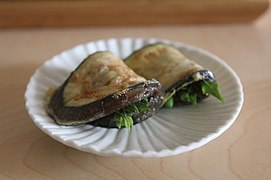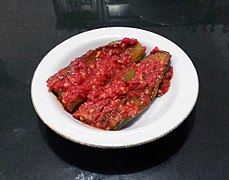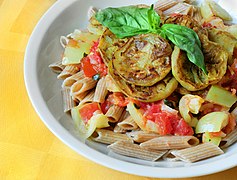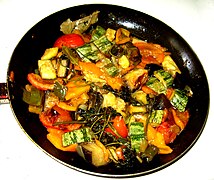Eggplant
| Eggplant | |
|---|---|
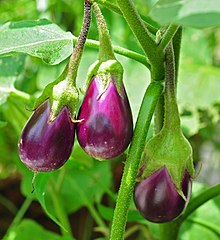
| |
| The fruit developing on the plant | |
| Scientific classification | |
| Kingdom: | Plantae |
| Clade: | Tracheophytes |
| Clade: | Angiosperms |
| Clade: | Eudicots |
| Clade: | Asterids |
| Order: | Solanales |
| Family: | Solanaceae |
| Genus: | Solanum |
| Subgenus: | Solanum subg. Leptostemonum |
| Section: | Solanum sect. Melongena |
| Species: | S. melongena
|
| Binomial name | |
| Solanum melongena | |
| Synonyms | |
|
Solanum ovigerum Dunal | |
Eggplant (US, CA, AU, NZ, PH), aubergine (UK,[1] IE), brinjal (IN, SG, MY, ZA), or baigan (IN, GY)[2][3] is a plant species in the nightshade family Solanaceae. Solanum melongena is grown worldwide for its edible fruit.
Most commonly purple, the spongy, absorbent fruit is used in several cuisines. Typically used as a vegetable in cooking, it is a berry by botanical definition. As a member of the genus Solanum, it is related to the tomato, chili pepper, and potato, although those are of the New World while the eggplant is of the Old World. Like the tomato, its skin and seeds can be eaten, but it is usually eaten cooked. Eggplant is nutritionally low in macronutrient and micronutrient content, but the capability of the fruit to absorb oils and flavors into its flesh through cooking expands its use in the culinary arts.
It was originally domesticated from the wild nightshade species thorn or bitter apple, S. incanum,[4][5][6] probably with two independent domestications: one in South Asia, and one in East Asia.[7] In 2021, world production of eggplants was 59 million tonnes, with China and India combined accounting for 86% of the total.
Description
The eggplant is a delicate, tropical perennial plant often cultivated as a tender or half-hardy annual in temperate climates. The stem is often spiny. The flowers are white to purple in color, with a five-lobed corolla and yellow stamens.[8] Some common cultivars have fruit that is egg-shaped, glossy, and purple with white flesh and a spongy, "meaty" texture. Some other cultivars are white and longer in shape. The cut surface of the flesh rapidly turns brown when the fruit is cut open (oxidation).[9]
Eggplant grows 40 to 150 cm (1 ft 4 in to 4 ft 11 in) tall,[10] with large, coarsely lobed leaves that are 10 to 20 cm (4 to 8 in) long and 5 to 10 cm (2 to 4 in) broad.[11] Semiwild types can grow much larger, to 225 cm (7 ft 5 in), with large leaves over 30 cm (12 in) long and 15 cm (6 in) broad. On wild plants, the fruit is less than 3 cm (1+1⁄4 in) in diameter[12]
Botanically classified as a berry, the fruit contains numerous small, soft, edible seeds that taste bitter because they contain or are covered in nicotinoid alkaloids, like the related tobacco.[13]
The eggplant genome has 12 chromosomes.[14]
History
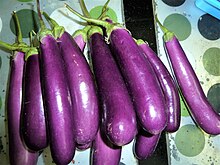

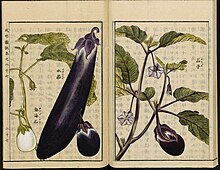
There is no consensus about the place of origin of eggplant; the plant species has been described as native to South Asia,[15][16] where it continues to grow wild, or Africa.[17] It has been cultivated in southern and eastern Asia since prehistory. The first known written record of the plant is found in Qimin Yaoshu, an ancient Chinese agricultural treatise completed in 544 CE.[18]
Eggplant was introduced to Europe through the Iberian Peninsula, where it became a staple among Muslim and Jewish communities.[19] The presence of numerous Arabic and North African names for the vegetable, coupled with the absence of ancient Greek and Roman names, suggests that it was cultivated in the Mediterranean area by Arabs during the early Middle Ages, arriving in Spain in the 8th century.[20] A book on agriculture by Ibn Al-Awwam in 12th-century Muslim Spain described how to grow aubergines.[21] Records exist from later medieval Catalan and Spanish,[22] as well as from 14th-century Italy.[23] Unlike its popularity in Spain and limited presence in southern Italy, the eggplant remained relatively obscure in other regions of Europe until the 17th century.[19]
The aubergine is unrecorded in England until the 16th century. An English botany book in 1597 described the madde or raging Apple:
This plant groweth in Egypt almost everywhere... bringing foorth fruite of the bignes of a great Cucumber.... We have had the same in our London gardens, where it hath borne flowers, but the winter approching before the time of ripening, it perished: notwithstanding it came to beare fruite of the bignes of a goose egge one extraordinarie temperate yeere... but never to the full ripenesse.[24]
The Europeans brought it to the Americas.[25]
Because of the plant's relationship with various other nightshades, the fruit was at one time believed to be extremely poisonous. The flowers and leaves can be poisonous if consumed in large quantities due to the presence of solanine.[26]
The eggplant has a special place in folklore. In 13th-century Italian traditional folklore, the eggplant can cause insanity.[27] In 19th-century Egypt, insanity was said to be "more common and more violent" when the eggplant is in season in the summer.[28]
Etymology and regional names

The plant and fruit have a profusion of English names.
Eggplant-type names
The name eggplant is usual in North American English and Australian English. First recorded in 1763, the word "eggplant" was originally applied to white cultivars, which look very much like hen's eggs (see image).[29][30][31] Similar names are widespread in other languages, such as the Icelandic term eggaldin or the Welsh planhigyn ŵy.
The white, egg-shaped varieties of the eggplant's fruits are also known as garden eggs,[32] a term first attested in 1811.[33] The Oxford English Dictionary records that between 1797 and 1888, the name vegetable egg was also used.[34]
Aubergine-type names
Whereas eggplant was coined in English, most of the diverse other European names for the plant derive from the Arabic: باذنجان bāḏinjān [bæːðɪnˈd͡ʒæːn] .[35] Bāḏinjān is itself a loan-word in Arabic, whose earliest traceable origins lie in the Dravidian languages. The Hobson-Jobson dictionary comments that "probably there is no word of the kind which has undergone such extraordinary variety of modifications, whilst retaining the same meaning, as this".[36]
In English usage, modern names deriving from Arabic bāḏinjān include:
- Aubergine, usual in British English (as well as German, French and Dutch).
- Brinjal or brinjaul, usual in South Asia and South African English.[37]
- Solanum melongena, the Linnaean name.
From Dravidian to Arabic

All the aubergine-type names have the same origin, in the Dravidian languages. Modern descendants of this ancient Dravidian word include Malayalam vaṟutina and Tamil vaṟutuṇai.[35]
The Dravidian word was borrowed into the Indo-Aryan languages, giving ancient forms such as Sanskrit and Pali vātiṅ-gaṇa (alongside Sanskrit vātigama) and Prakrit vāiṃaṇa. According to the entry brinjal in the Oxford English Dictionary, the Sanskrit word vātin-gāna denoted 'the class (that removes) the wind-disorder (windy humour)': that is, vātin-gāna came to be the name for eggplants because they were thought to cure flatulence. The modern Hindustani words descending directly from the Sanskrit name are baingan and began.[38]
The Indic word vātiṅ-gaṇa was then borrowed into Persian as bādingān. Persian bādingān was borrowed in turn into Arabic as bāḏinjān (or, with the definite article, al-bāḏinjān). From Arabic, the word was borrowed into European languages.[35]
From Arabic into Iberia and beyond
In al-Andalus, the Arabic word (al-)bāḏinjān was borrowed into the Romance languages in forms beginning with b- or, with the definite article included, alb-:[35]
- Portuguese bringella, bringiela, beringela.[38]
- Spanish berenjena, alberenjena.
The Spanish word alberenjena was then borrowed into French, giving aubergine (along with French dialectal forms like albergine, albergaine, albergame, and belingèle). The French name was then borrowed into British English, appearing there first in the late eighteenth century.[35]
Through the colonial expansion of Portugal, the Portuguese form bringella was borrowed into a variety of other languages:[35]
- Indian, Malaysian, Singaporean and South African English brinjal, brinjaul (first attested in the seventeenth century).
- West Indian English brinjalle and (through folk-etymology) brown-jolly.
- French bringelle in La Réunion.
Thus although Indian English brinjal ultimately originates in languages of the Indian Subcontinent, it actually came into Indian English via Portuguese.
From Arabic into Greek and beyond

The Arabic word bāḏinjān was borrowed into Greek by the eleventh century CE. The Greek loans took a variety of forms, but crucially they began with m-, partly because Greek lacked the initial b- sound and partly through folk-etymological association with the Greek word μέλας (melas), 'black'. Attested Greek forms include ματιζάνιον (matizanion, eleventh-century), μελιντζάνα (melintzana, fourteenth-century), and μελιντζάνιον (melintzanion, seventeenth-century).[35]
From Greek, the word was borrowed into Italian and medieval Latin, and onwards into French. Early forms include:[35]
- Melanzāna, recorded in Sicilian in the twelfth century.
- Melongena, recorded in Latin in the thirteenth century.
- Melongiana, recorded in Veronese in the fourteenth century.
- Melanjan, recorded in Old French.
From these forms came the botanical Latin melongēna. This was used by Tournefort as a genus name in 1700, then by Linnaeus as a species name in 1753. It remains in scientific use.[35]
These forms also gave rise to the Caribbean English melongene.[35]
The Italian melanzana, through folk-etymology, was adapted to mela insana ('mad apple'): already by the thirteenth century, this name had given rise to a tradition that eggplants could cause insanity. Translated into English as 'mad-apple',[39] 'rage-apple', or 'raging apple', this name for eggplants is attested from 1578 and the form 'mad-apple' may still be found in Southern American English.[40]
Other English names
The plant is also known as guinea squash in Southern American English. The term guinea in the name originally denoted the fact that the fruits were associated with West Africa, specifically the region that is now the modern day country Guinea.[40]
It has been known as 'Jew's apple',[39][41] apparently in relation to a belief that the fruit was first imported to the West Indies by Jewish people.[41]
Cultivars
This section includes a list of references, related reading, or external links, but its sources remain unclear because it lacks inline citations. (December 2018) |
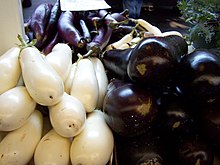
Different cultivars of the plant produce fruit of different size, shape, and color, though typically purple. The less common white varieties of eggplant are also known as Easter white eggplants, garden eggs, Casper or white eggplant. The most widely cultivated varieties—cultivars—in Europe and North America today are elongated ovoid, 12–25 cm (4+1⁄2–10 in) long and 6–9 cm (2+1⁄2–3+1⁄2 in) broad with a dark purple skin.
A much wider range of shapes, sizes, and colors is grown in India and elsewhere in Asia. Larger cultivars weighing up to a kilogram (2.2 pounds) grow in the region between the Ganges and Yamuna Rivers, while smaller ones are found elsewhere.[citation needed] Colors vary from white to yellow or green, as well as reddish-purple and dark purple. Some cultivars have a color gradient—white at the stem, to bright pink, deep purple or even black. Green or purple cultivars with white striping also exist. Chinese cultivars are commonly shaped like a narrower, slightly pendulous cucumber. Also, Asian cultivars of Japanese breeding are grown.
- Oval or elongated oval-shaped and black-skinned cultivars include 'Harris Special Hibush', 'Burpee Hybrid', 'Bringal Bloom', 'Black Magic', 'Classic', 'Dusky', and 'Black Beauty'.
- Slim cultivars in purple-black skin include 'Little Fingers', 'Ichiban', 'Pingtung Long', and 'Tycoon'
- In green skin, 'Louisiana Long Green' and 'Thai (Long) Green'
- In white skin, 'Dourga'.
- Traditional, white-skinned, egg-shaped cultivars include 'Casper' and 'Easter Egg'.
- Bicolored cultivars with color gradient include 'Rosa Bianca', 'Violetta di Firenze', 'Bianca Sfumata di Rosa' (heirloom), and 'Prosperosa' (heirloom).
- Bicolored cultivars with striping include 'Listada de Gandia' and 'Udumalapet'.
- In some parts of India, miniature cultivars, most commonly called baigan, are popular.
Varieties
- S. m. var. esculentum – common aubergine, including white varieties, with many cultivars[42]
- S. m. var. depressum – dwarf aubergine
- S. m. var. serpentium – snake aubergine
Genetically engineered eggplant
Bt brinjal is a transgenic eggplant that contains a gene from the soil bacterium Bacillus thuringiensis.[43] This variety was designed to give the plant resistance to lepidopteran insects such as the brinjal fruit and shoot borer (Leucinodes orbonalis) and fruit borer (Helicoverpa armigera).[43][44]
On 9 February 2010, the Environment Ministry of India imposed a moratorium on the cultivation of Bt brinjal after protests against regulatory approval of cultivated Bt brinjal in 2009, stating the moratorium would last "for as long as it is needed to establish public trust and confidence".[43] This decision was deemed controversial, as it deviated from previous practices with other genetically modified crops in India.[45] Bt brinjal was approved for commercial cultivation in Bangladesh in 2013.[46]
Uses
Culinary
This section needs additional citations for verification. (August 2018) |
Raw eggplant can have a bitter taste, with an astringent quality, but it becomes tender when cooked and develops a rich, complex flavor. Rinsing, draining, and salting the sliced fruit before cooking may remove the bitterness.[47] The fruit is capable of absorbing cooking fats and sauces, which may enhance the flavor of eggplant dishes.
Eggplant is used in the cuisines of many countries. Due to its texture and bulk, it is sometimes used as a meat substitute in vegan and vegetarian cuisines.[48] Eggplant flesh is smooth. Its numerous seeds are small, soft and edible, along with the rest of the fruit, and do not have to be removed. Its thin skin is also edible, and so it does not have to be peeled. However, the green part at the top, the calyx, does have to be removed when preparing an eggplant for cooking.
Eggplant can be steamed, stir-fried, pan fried, deep fried, barbecued, roasted, stewed, curried, or pickled. Many eggplant dishes are sauces made by mashing the cooked fruit. It can be stuffed. It is frequently, but not always, cooked with oil or fat.
East Asia
Korean and Japanese eggplant varieties are typically thin-skinned.[49]
In Chinese cuisine, eggplants are known as qiézi (茄子). They are often deep fried and made into dishes such as yúxiāng-qiézi ("fish fragrance eggplant")[50] or di sān xiān ("three earthen treasures"). Elsewhere in China, such as in Yunnan cuisine (in particular the cuisine of the Dai people) they are barbecued or roasted, then split and either eaten directly with garlic, chilli, oil and coriander, or the flesh is removed and pounded to a mash (typically with a wooden pestle and mortar) before being eaten with rice or other dishes.
In Japanese cuisine, eggplants are known as nasu or nasubi and use the same characters as Chinese (茄子). An example of it use is in the dish hasamiyaki (挟み焼き) in which slices of eggplant are grilled and filled with a meat stuffing.[51] Eggplants also feature in several Japanese expression and proverbs, such as "Don't feed autumn eggplant to your wife" (秋茄子は嫁に食わすな, akinasu wa yome ni kuwasuna) (because their lack of seeds will reduce her fertility) and "Always listen to your parents" (親の意見と茄子の花は千に一つも無駄はない, oya no iken to nasu no hana wa sen ni hitotsu mo muda wa nai, literally: "not even one in a thousand of one's parents' opinions or the eggplant flowers is in vain").[52][53]
In Korean cuisine, eggplants are known as gaji (가지). They are steamed, stir-fried, or pan-fried and eaten as banchan (side dishes), such as namul, bokkeum, and jeon.[54][55]
-
Chinese yúxiāng-qiézi (fish-fragrance eggplants)
Southeast Asia
In the Philippines, eggplants are of the long and slender purple variety. They are known as talong and is widely used in many stew and soup dishes, like pinakbet.[56] However the most popular eggplant dish is tortang talong, an omelette made from grilling an eggplant, dipping it into beaten eggs, and pan-frying the mixture. The dish is characteristically served with the stalk attached. The dish has several variants, including rellenong talong which is stuffed with meat and vegetables.[57][58] Eggplant can also be grilled, skinned and eaten as a salad called ensaladang talong.[59] Another popular dish is adobong talong, which is diced eggplant prepared with vinegar, soy sauce, and garlic as an adobo.[60]
-
Indonesian chili terong sauce with shrimp
-
Minang (West Sumatra) balado terong
-
Sweet and sour fish head with terong
-
Simple fried terong from Gorontalo (Sulawesi)
-
Philippine ensaladang talong, a salad on grilled and skinned green eggplant
South Asia
Eggplant is widely used in its native India, for example in sambar (a tamarind lentil stew), dalma (a dal preparation with vegetables, native to Odisha), chutney, curry (vankai[61]), and achaar (a pickled dish). Owing to its versatile nature and wide use in both everyday and festive Indian food, it is often described as the "king of vegetables". Roasted, skinned, mashed, mixed with onions, tomatoes, and spices, and then slow cooked gives the South Asian dish baingan bharta or gojju, similar to salată de vinete in Romania. Another version of the dish, begun-pora (eggplant charred or burnt), is very popular in Bangladesh and the east Indian states of Odisha and West Bengal where the pulp of the vegetable is mixed with raw chopped shallot, green chilies, salt, fresh coriander, and mustard oil. Sometimes fried tomatoes and deep-fried potatoes are also added, creating a dish called begun bhorta. In a dish from Maharashtra called bharli vangi, small brinjals are stuffed with ground coconut, peanuts, onions, tamarind, jaggery and masala spices, and then cooked in oil. Maharashtra and the adjacent state of Karnataka also have an eggplant-based vegetarian pilaf called 'vangi bhat' [62]..
-
Brinjal masala fry
-
Brinjal and mango sambar
Middle East and the Mediterranean
Eggplant is often stewed, as in the French ratatouille, or deep-fried as in the Italian parmigiana di melanzane, the Turkish karnıyarık, or Turkish, Greek, and Levantine musakka/moussaka, and Middle Eastern and South Asian dishes. Eggplants can also be battered before deep-frying and served with a sauce made of tahini and tamarind. In Iranian cuisine, it is blended with whey as kashk e bademjan, tomatoes as mirza ghassemi, or made into stew as khoresht-e-bademjan. It can be sliced and deep-fried, then served with plain yogurt (optionally topped with a tomato and garlic sauce), such as in the Turkish dish patlıcan kızartması (meaning fried aubergines), or without yogurt, as in patlıcan şakşuka. Perhaps the best-known Turkish eggplant dishes are imam bayıldı (vegetarian) and karnıyarık (with minced meat). It may also be roasted in its skin until charred, so the pulp can be removed and blended with other ingredients, such as lemon, tahini, and garlic, as in the Levantine baba ghanoush, Greek melitzanosalata, Moroccan zaalouk[63] and Romanian salată de vinete.[64][65] A mix of roasted eggplant, roasted red peppers, chopped onions, tomatoes, mushrooms, carrots, celery, and spices is called zacuscă in Romania, and ajvar or pinjur in the Balkans.
A Spanish dish called escalivada in Catalonia calls for strips of roasted aubergine, sweet pepper, onion, and tomato. In Andalusia, eggplant is mostly cooked thinly sliced, deep-fried in olive oil and served hot with honey (berenjenas a la Cordobesa). In the La Mancha region of central Spain, a small eggplant is pickled in vinegar, paprika, olive oil, and red peppers. The result is berenjena of Almagro, Ciudad Real. A Levantine specialty is makdous, another pickling of eggplants, stuffed with red peppers and walnuts in olive oil. Eggplant can be hollowed out and stuffed with meat, rice, or other fillings, and then baked. In Georgia, for example, it is fried and stuffed with walnut paste to make nigvziani badrijani.[39]
In medieval Spain, eggplant, along with ingredients such as Swiss chard and chickpeas, was closely associated with Jewish cuisine.[66] The Kitāb al-Ṭabikh, a 13th-century Andalusian cookbook, features eggplant as the main ingredient in fifteen out of its nineteen vegetable dishes, indicating its significance in the local cuisine at the time.[67] Jewish communities in Spain prepared eggplant in various ways, including in dishes like almodrote, a casserole of eggplant and cheese. This dish and others became identifiers for Jews during their expulsion from Spain and the Inquisition, and they were carried by the expelled Jews to their new homes in the Ottoman Empire.[66] The classic Judaeo-Spanish song "Siete modos de gizar la berendgena" lists various methods of preparing eggplant that persisted among Jews in the Ottoman Empire.[66][68] Today, eggplant remains a defining ingredient of Sephardic Jewish cuisine.[69]
-
Parmigiana di melanzane (eggplant parmesan)
-
Greek moussaka
-
Almagro eggplant
-
Ratatouille niçoise
-
Romanian eggplant salad (salată de vinete)
Iran
In Iranian cuisine, eggplant (called bādenjān or bādemjān in Persian) can be used in both appetizers and main courses.[70] It can also be pickled in vinegar.[70] The ideal eggplant in Iranian cuisine is long, straight, firm, and black.[70] Based on how al-Razi uses the color of eggplant as a shorthand for purpleness in his Kitab al-hawi, it can be assumed that the dark purple kind of eggplant was the widely grown variety in Iran at his time (9th century).[70] Its importance in Iran is alluded to in the Ain-i-Akbari of Abu'l-Fazl ibn Mubarak, which says "this vegetable is on sale in the markets in Iran all the year round and in such abundance that it is sold for 1.5 dams per seer" (which was a cheap price at that time).[70]
In Iran, unlike places like Greece, Turkey, and North Africa, eggplant is cooked peeled and usually seasoned with cinnamon or especially turmeric.[70] Most eggplant dishes are classified as nankhoreshi (eaten with bread), and they are commonly served as snacks alongside alcoholic beverages.[70]
The 14th-century poet Boshaq At'ema refers to an early eggplant dish called burani-e badenjan: chopped eggplant sautéed with onions and turmeric, then slowly cooked, and finally mixed with yogurt.[70] The combination of eggplant and kashk (condensed whey) is popular in Iranian cuisine; it is found in dishes like kashk o badenjan as well as ash-e kashk o badenjan (involving layers of sautéed eggplant, grilled onions, and red beans topped by kashk seasoned with turmeric).[70] Another eggplant dish is mast o badenjan, also known as nazkhatun in Tehran, which involves eggplant, yogurt, and dried mint.[70] Eggplant can also be cooked in stews (khoreshes), either with lamb (khoresh-e badenjan) or with chicken and either unripe grapes or pomegranate juice (mosamma-ye badenjan).[70] Variants of ab-gusht, eshkana, fesenjan, and kuku also make use of eggplant.[70] Some regional dishes involving eggplant include badenjan-polow, a dish mainly from Fars and Kerman that combines white rice with a paste of chopped sautéed eggplant, chopped meat, and spices; as well as the northern Iranian badenjan-e qasemi, a casserole using grilled eggplant, garlic, tomatoes, and eggs.[70]
Eggplants are traditionally among the foods that get preserved and stored for winter in Iran.[70] They are selected in the last month of summer, when they are most readily available, then peeled, and finally preserved in one of two ways.[70] In the first way, the peeled eggplants are cut, salted, and left to "sweat" (to make them less bilious); then they are sun-dried by hanging them on a line.[70] The dried eggplants are then rehydrated 24 hours before being cooked.[70] In the second way, the peeled eggplants are cooked in oil, put in a copper pot, and finally covered with plenty of hot oil, "which congeals to seal them".[70]
Medieval Iranian writers such as al-Razi and al-Biruni cautioned that eggplant contains harmful qualities, and it must be ripe and cooked before eating to neutralize them.[70] They wrote that it could cause heat and dryness and an excess of black bile, contributing to a wide range of health problems.[70] If the "salt" in it was removed, or it was cooked in oil or vinegar, then they wrote that eggplant gained healthy attributes.[70] Present-day Iranian attitudes to the eggplant reflect this medical tradition's influence: the eggplant is "considered rather dangerous... a cook in Tehran will say that the poison must be taken out".[70] People also use eggplant seeds as an expectorant to relieve asthma and catarrh.[70]
Nutrition
| Nutritional value per 100 g (3.5 oz) | |||||||||||||||||||||||||||||||||||||||||||||
|---|---|---|---|---|---|---|---|---|---|---|---|---|---|---|---|---|---|---|---|---|---|---|---|---|---|---|---|---|---|---|---|---|---|---|---|---|---|---|---|---|---|---|---|---|---|
| Energy | 104 kJ (25 kcal) | ||||||||||||||||||||||||||||||||||||||||||||
5.88 g | |||||||||||||||||||||||||||||||||||||||||||||
| Sugars | 3.53 g | ||||||||||||||||||||||||||||||||||||||||||||
| Dietary fiber | 3 g | ||||||||||||||||||||||||||||||||||||||||||||
0.18 g | |||||||||||||||||||||||||||||||||||||||||||||
0.98 g | |||||||||||||||||||||||||||||||||||||||||||||
| |||||||||||||||||||||||||||||||||||||||||||||
| Other constituents | Quantity | ||||||||||||||||||||||||||||||||||||||||||||
| Water | 92 g | ||||||||||||||||||||||||||||||||||||||||||||
| †Percentages estimated using US recommendations for adults,[71] except for potassium, which is estimated based on expert recommendation from the National Academies.[72] | |||||||||||||||||||||||||||||||||||||||||||||
Raw eggplant is 92% water, 6% carbohydrates, 1% protein, and has negligible fat (table). It provides low amounts of essential nutrients, with only manganese having a moderate percentage (10%) of the Daily Value. Minor changes in nutrient composition occur with season, environment of cultivation (open field or greenhouse), and genotype.[73]
Cultivation and pests
In tropical and subtropical climates, eggplant can be sown in the garden. Eggplant grown in temperate climates fares better when transplanted into the garden after all danger of frost has passed. Eggplant prefers hot weather, and when grown in cold climates or in areas with low humidity, the plants languish or fail to set and produce mature fruit.[74][75] Seeds are typically started eight to 10 weeks prior to the anticipated frost-free date. S. melongena is included on a list of low flammability plants, indicating that it is suitable for growing within a building protection zone.[76]
Spacing should be 45 to 60 cm (18 to 24 in) between plants, depending on cultivar, and 60 to 90 cm (24 to 35 in) between rows, depending on the type of cultivation equipment being used. Mulching helps conserve moisture and prevent weeds and fungal diseases and the plants benefit from some shade during the hottest part of the day. Hand pollination by shaking the flowers improves the set of the first blossoms. Growers typically cut fruits from the vine just above the calyx owing to the somewhat woody stems. Flowers are complete, containing both female and male structures, and may be self- or cross-pollinated.[77]
Many of the pests and diseases that afflict other solanaceous plants, such as tomato, capsicum, and potato, are also troublesome to eggplants. For this reason, it should generally not be planted in areas previously occupied by its close relatives. However, since eggplants can be particularly susceptible to pests such as whiteflies, they are sometimes grown with slightly less susceptible plants, such as chili pepper, as a sacrificial trap crop. Four years should separate successive crops of eggplants to reduce pest pressure.[78]
Common North American pests include the potato beetles, flea beetles, aphids, whiteflies, and spider mites. Good sanitation and crop rotation practices are extremely important for controlling fungal disease, the most serious of which is Verticillium.[79]
The potato tuber moth (Phthorimaea operculella) is an oligophagous insect that prefers to feed on plants of the family Solanaceae such as eggplants. Female P. operculella use the leaves to lay their eggs and the hatched larvae will eat away at the mesophyll of the leaf.[80]
Several different Phytoplasmas cause little leaf of brinjal, which is agriculturally significant in South Asia. This is spread by the leafhopper Hishimonus phycitis.[citation needed]
Production
| Country | Production million tonnes |
|---|---|
| 38 | |
| 13 | |
| 1.4 | |
| 0.8 | |
| 0.7 | |
| World | 59 |
| Source: FAOSTAT of the United Nations[81] | |
In 2022, world production was 59 million tonnes, led by China with 65% and India with 22% (table).
Chemistry
The color of purple skin cultivars is due to the anthocyanin nasunin.[82]
The browning of eggplant flesh results from the oxidation of polyphenols, such as the most abundant phenolic compound in the fruit, chlorogenic acid.[83]
Allergies
Case reports of itchy skin or mouth, mild headache, and stomach upset after handling or eating eggplant have been reported anecdotally and published in medical journals (see also oral allergy syndrome).[84] A 2021 review indicated that possibly four interacting mechanisms may elicit an allergic response from consuming eggplant: lipid transfer protein, profilin, polyphenol oxidase, and pollen reactions.[84][85]
A 2008 study of a sample of 741 people in India, where eggplant is commonly consumed, found nearly 10% reported some allergic symptoms after consuming eggplant, with 1.4% showing symptoms within two hours.[86] Contact dermatitis from eggplant leaves and allergy to eggplant flower pollen have also been reported.[87][88]
Individuals who are atopic (genetically predisposed to developing certain allergic hypersensitivity reactions) are more likely to have a reaction to eggplant, which may be because eggplant is high in histamines.[84] Cooking eggplant thoroughly seems to preclude reactions in some individuals, but some of the allergenic proteins may survive the cooking process.
Taxonomy

The eggplant is quite often featured in the older scientific literature under the junior synonyms S. ovigerum and S. trongum. Several other names that are now invalid have been uniquely applied to it:[89]
- Melongena ovata Mill.
- Solanum album Noronha
- Solanum insanum L.
- Solanum longum Roxb.
- Solanum melanocarpum Dunal
- Solanum melongenum St.-Lag.
- Solanum oviferum Salisb.
- Prachi Salisb.
A number of subspecies and varieties have been named, mainly by Dikii, Dunal, and (invalidly) by Sweet. Names for various eggplant types, such as agreste, album, divaricatum, esculentum, giganteum, globosi, inerme, insanum, leucoum, luteum, multifidum, oblongo-cylindricum, ovigera, racemiflorum, racemosum, ruber, rumphii, sinuatorepandum, stenoleucum, subrepandum, tongdongense, variegatum, violaceum, viride, are not considered to refer to anything more than cultivar groups at best. However, Solanum incanum and cockroach berry (S. capsicoides), other eggplant-like nightshades described by Linnaeus and Allioni, respectively, were occasionally considered eggplant varieties, but this is not correct.[89]
The eggplant has a long history of taxonomic confusion with the scarlet and Ethiopian eggplants (Solanum aethiopicum), known as gilo and nakati, respectively, and described by Linnaeus as S. aethiopicum. The eggplant was sometimes considered a variety violaceum of that species. S. violaceum of de Candolle applies to Linnaeus' S. aethiopicum. An actual S. violaceum, an unrelated plant described by Ortega, included Dunal's S. amblymerum and was often confused with the same author's S. brownii.[89]
Like the potato and S. lichtensteinii, but unlike the tomato, which then was generally put in a different genus, the eggplant was also described as S. esculentum, in this case once more in the course of Dunal's work. He also recognized the varieties aculeatum, inerme, and subinerme at that time. Similarly, H.C.F. Schuhmacher and Peter Thonning named the eggplant as S. edule, which is also a junior synonym of sticky nightshade (S. sisymbriifolium). Scopoli's S. zeylanicum refers to the eggplant, and that of Blanco to S. lasiocarpum.[89]
See also
References
- ^ "Aubergine", Oxford English Dictionary, undated Archived 2015-08-10 at the Wayback Machine. Retrieved: 7 August 2015.
- ^ "Oxford Dictionary, s.v. brinjal". Oxford University Press. Archived from the original on 1 April 2016. Retrieved 4 April 2016.
- ^ "Etymology of the Eggplant". 21 June 2005.
- ^ Tsao and Lo in "Vegetables: Types and Biology". Handbook of Food Science, Technology, and Engineering by Yiu H. Hui (2006). CRC Press. ISBN 1-57444-551-0.
- ^ Doijode, S. D. (2001). Seed storage of horticultural crops (pp 157). Haworth Press: ISBN 1-56022-901-2
- ^ Doganlar, Sami; Frary, Anne; Daunay, Marie-Christine; Lester, Richard N.; Tanksley, Steven D. (1 August 2002). "A Comparative Genetic Linkage Map of Eggplant (Solanum melongena) and Its Implications for Genome Evolution in the Solanaceae". Genetics. 161 (4): 1697–1711. doi:10.1093/genetics/161.4.1697. PMC 1462225. PMID 12196412. Archived from the original on 11 March 2016. Retrieved 3 August 2012 – via www.genetics.org.
- ^ "Solanum melongena". Germplasm Resources Information Network. Agricultural Research Service, United States Department of Agriculture. Retrieved 20 November 2014.
- ^ "Solanum melongena (eggplant): Go Botany". gobotany.nativeplanttrust.org. Retrieved 20 June 2024.
- ^ Liu, Xiaohui; Zhang, Aidong; Shang, Jing; Zhu, Zongwen; Li, Ye; Wu, Xuexia; Zha, Dingshi (25 March 2021). "Study on browning mechanism of fresh-cut eggplant (Solanum melongena L.) based on metabolomics, enzymatic assays and gene expression". Scientific Reports. 11 (1): 6937. Bibcode:2021NatSR..11.6937L. doi:10.1038/s41598-021-86311-1. ISSN 2045-2322. PMC 7994816. PMID 33767263.
- ^ "How To Grow And Care For Eggplant". Southern Living. Retrieved 20 June 2024.
- ^ "Solanum melongena (Aubergine, Brinjal, Eggplant, Mad Apple, Raging Apple) | North Carolina Extension Gardener Plant Toolbox". plants.ces.ncsu.edu. Retrieved 20 June 2024.
- ^ "Foraged Eggplant". specialtyproduce.com. Retrieved 20 June 2024.
- ^ "Eggplant". University of Florida. Retrieved 20 October 2023.
- ^ Wei, Q; Wang, J; Wang, W; Hu, T; Bao, C (2020). "A high-quality chromosome-level genome assembly reveals genetics for important traits in eggplant". Horticulture Research. 7 (153): 1–15. Bibcode:2020HorR....7..153W. doi:10.1038/s41438-020-00391-0. PMC 7506008. PMID 33024567.PDF
- ^ Foundation, Encyclopaedia Iranica. "Welcome to Encyclopaedia Iranica". iranicaonline.org. Retrieved 22 April 2021.
The plant is native to South Asia and was domesticated in India. It was brought to the Iranian lands at a very early but indeterminable date.
- ^ Trujilo, Linda (25 January 2003), "The Elegant Eggplant", Master Gardener Journal, archived from the original on 4 December 2016, retrieved 16 September 2018
- ^ Matthee, Rudolph (11 February 2016). "Patterns of Food Consumption in Early Modern Iran". Oxford Handbook Topics in History. doi:10.1093/oxfordhb/9780199935369.013.13. ISBN 978-0-19-993536-9.
Eggplant, which originated in Africa, first shows up in history in Southeast Asia, and it was possibly brought to Iran in the same period from India via the Turks of Central Asia.
- ^ Dunlop, Fuchsia (2006), Revolutionary Chinese Cookbook: Recipes from Hunan Province, Ebury Press, p. 202
- ^ a b Gitlitz, David M.; Davidson, Linda Kay (1999). A Drizzle of Honey: the lives and recipes of Spain's secret Jews. New York: St. Martin's Press. pp. xiv. ISBN 978-0-312-19860-2.
- ^ Sanderson, Helen; Renfrew, Jane M. (2005). Prance, Ghillean; Nesbitt, Mark (eds.). The Cultural History of Plants. Routledge. p. 118. ISBN 0415927463.
- ^ The Book of Agriculture by Ibn Al-Awwam Archived 2015-10-03 at the Wayback Machine, translated from Arabic to French by J.-J. Clément-Mullet, year 1866, volume 2 page 236.
- ^ The first record of Catalan albergínia = "aubergine" is in 1328 according to the Catalan dictionary Diccionari.cat Archived 2013-11-10 at the Wayback Machine. An earlier record in Catalan is known, from the 13th century, according to the French Centre National de Ressources Textuelles et Lexicales Archived 2013-05-14 at the Wayback Machine. A number of old variant spellings for the aubergine word in Romance dialects in Iberia indicate the word was borrowed from Arabic; Dictionary of Arabic and Allied Loanwords: Spanish, Portuguese, Catalan, Galician and Kindred Dialects Archived 2015-10-03 at the Wayback Machine, by Federico Corriente, year 2008 page 60.
- ^ Mane, Perrine (2008). "Les fruits et les légumes dans les livres de cuisine à la fin du Moyen Âge" [Fruits and vegetables in late medieval cookbooks]. Publications de l'Académie des Inscriptions et Belles-Lettres (Part of a thematic issue: Pratiques et discours alimentaires en Méditerranée de l'Antiquité à la Renaissance) (in French). 19: 409–436. Retrieved 30 April 2023. p. 418
- ^ The Herball, or Generall Historie of Plantes Archived 2014-01-02 at the Wayback Machine, by John Gerarde, year 1597 page 274.
- ^ Gebhardt, Christiane (2016). "The historical role of species from the Solanaceae plant family in genetic research". Theor Appl Genet. 129 (12): 2281–2294. doi:10.1007/s00122-016-2804-1. PMC 5121176. PMID 27744490.
Later, it migrated with the Europeans to America
citing Daunay M-C, Laterrot H, Janick J (2008) Iconography and History of Solanaceae: Antiquity to the 17th Century. Horticultural Reviews. Wiley, New York, pp 1–111 - ^ "Is Raw Eggplant Poisonous?". Kitchen Daily. 30 August 2012. Archived from the original on 5 September 2012. Retrieved 5 September 2012.
- ^ Oxford English Dictionary, 3rd edition, 2000, s.v. 'mad-apple'
- ^ Edward William Lane, An Account of the Manners and Customs of the Modern Egyptians, v. 1, p. 378, footnote 1.
- ^ "Eggplant". Online Etymology Dictionary, Douglas Harper. 2017. Retrieved 8 December 2017.
- ^ "Eggplant". World Wide Worlds. 20 October 2002. Archived from the original on 9 December 2017. Retrieved 8 December 2017.
- ^ "'egg-plant, n." OED Online, Oxford University Press, July 2018. Accessed 23 September 2018.
- ^ 'Eggplant (Garden Egg) Archived 2018-09-23 at the Wayback Machine', in National Research Council of the National Academies, Lost Crops of Africa, Volume II: Vegetables Archived 2018-09-23 at the Wayback Machine (Washington, D.C.: The National Academies Press, 2006), pp. 136-53. ISBN 978-0-309-66582-7, doi:10.17226/11763.
- ^ 'Garden egg', in "garden, n." OED, 3rd edn (2017).
- ^ 'Vegetable egg, n.', OED, 3rd edn (2012).
- ^ a b c d e f g h i j Oxford English Dictionary, 3rd edition, 2001, s.v. 'melongena, n.'; 2000, s.v. 'melongene, n."; and 2000, s.v. 'mad-apple, n.'. These partly supersede the etymology in Oxford English Dictionary, 1st edition, 1888, s.v. 'brinjal'. This in turn supersedes the 1885 OED etymology s.v. 'aubergine'.
- ^ Henry Yule, A.C. Burnell, Hobson-Jobson: The Anglo-Indian Dictionary, 1886, reprint ISBN 185326363X, p. 115, s.v. 'brinjaul'
- ^ "Brinjal". Oxford University Press. Archived from the original on 12 June 2018. Retrieved 28 August 2018.
- ^ a b Oxford English Dictionary, 1st edition, 1888, s.v. 'brinjal'.
- ^ a b c Lim, T. K., & Lim, T. K. (2013). Solanum melongena. Edible Medicinal And Non-Medicinal Plants: Volume 6, Fruits, p. 370-372
- ^ a b "Guinea squash". Carolina Gold Rice Foundation. 4 April 2011. Archived from the original on 10 November 2017. Retrieved 9 November 2017.
- ^ a b "brown-jolly", in "brown, adj.", "Jews' apple" in "Jew, n." OED Online, Oxford University Press, July 2018. Accessed 23 September 2018.
- ^ Stephens, James M. "Eggplant, White — Solanum ovigerum Dun. and Solanum melongena var. esculentum (L.) Nees" (PDF). University of Florida IFAS Extension. Archived (PDF) from the original on 9 October 2012. Retrieved 31 August 2012.
- ^ a b c Kumar S, Misra A, Verma AK, Roy R, Tripathi A, Ansari KM, Das M, Dwivedi PD (2011). "Bt brinjal in India: a long way to go". GM Crops. 2 (2): 92–8. doi:10.4161/gmcr.2.2.16335. PMID 21865863. S2CID 10912063.
- ^ Kumar S, Chandra A, Pandey KC (2008). "Bacillus thuringiensis (Bt) transgenic crop: an environment friendly insect-pest management strategy". J Environ Biol. 29 (5): 641–53. PMID 19295059.
- ^ Choudhary B, Gheysen G, Buysse J, van der Meer P, Burssens S (2014). "Regulatory options for genetically modified crops in India". Plant Biotechnol J. 12 (2): 135–46. doi:10.1111/pbi.12155. PMID 24460889.
- ^ IANS (7 September 2016). "Bt Brinjal in Bangladesh: Too early to draw conclusions on contamination, says expert". Business Standard India. Archived from the original on 1 December 2016. Retrieved 1 December 2016.
- ^ "Aubergine". BBC GoodFood. Archived from the original on 16 November 2018. Retrieved 16 November 2018.
- ^ "Vegetarian Meat Substitutes". Archived from the original on 9 February 2013. Retrieved 21 April 2013.
- ^ JinPittsburgh, Liyun (13 August 2009). "Korean restaurant owner cooks from the heart Andy Starnes/Post-Gazette". Post-Gazette. Archived from the original on 3 February 2018. Retrieved 3 February 2018.
- ^ Leary, Charles L.; Perret, Vaughn J. (6 July 2017). "All the hallmarks of world-class cuisine". The Chronicle Herald. Archived from the original on 3 February 2018. Retrieved 3 February 2018.
- ^ "Jisho.org: Japanese Dictionary". jisho.org.
- ^ "Jisho.org: Japanese Dictionary". jisho.org.
- ^ "親の意見と茄子の花は千に一つも無駄はない - Jisho.org". jisho.org.
- ^ Maclang, Jon Khristian (25 March 2016). "North, South, Go Pick! Tasting Korean Fare in Beijing". Yibada. Archived from the original on 3 February 2018. Retrieved 3 February 2018.
- ^ The Korea Herald (14 August 2017). "Fuss-free stir-fried eggplants, a perfect side dish". The Straits Times. Archived from the original on 3 February 2018. Retrieved 3 February 2018.
- ^ Norma Olizon-Chikiamco (2003). Filipino Favorites. Periplus Mini Cookbooks. Tuttle Publishing. ISBN 9781462911028. Archived from the original on 6 December 2018. Retrieved 6 December 2018.
- ^ Nicole Ponseca & Miguel Trinidad (2018). I Am a Filipino: And This Is How We Cook. Artisan Books. ISBN 9781579658823. Archived from the original on 6 December 2018. Retrieved 6 December 2018.
- ^ "The Happy Home Cook: Rellenong Talong (Stuffed Eggplant)". Positively Filipino. 17 August 2016. Archived from the original on 6 December 2018. Retrieved 6 December 2018.
- ^ "Ensaladang talong". Eat Your World. Archived from the original on 6 December 2018. Retrieved 6 December 2018.
- ^ "Adobong Talong". Kawaling Pinoy. 19 January 2014. Archived from the original on 6 December 2018. Retrieved 6 December 2018.
- ^ Khiangte, Zorinpuii; Lalramnghinglova, H (2017). "An Ethno Botanical Study of Ralte Communities in the North Eastern Part of Mizoram, North East India". Journal of Natural Product and Plant Resources. 7 (4). India: Mizoram University. Retrieved 21 August 2023.
- ^ "Maharashtrian Vangi Bhat recipe". Retrieved 5 January 2020.[dead link] Accessed Jan 2 2019
- ^ Wolfert, Paula (1 January 2012). The Food of Morocco. A&C Black. p. 93. ISBN 978-1-4088-2746-8.
- ^ Marin, Sanda (1995). Carte de bucate (Cookbook) (in Romanian). București (Bucharest): Editura Orizonturi. pp. 31–32. ISBN 973-95583-2-1.
- ^ Jurcovan, Silvia (2012). Carte de bucate (Cookbook) (in Romanian). București (Bucharest): Editura Humanitas. pp. 90–91. ISBN 978-973-50-3475-7.
- ^ a b c Gardner, S. M. (2018). The Good Woman Makes the Empty Kitchen Full: the Culinary and Cultural Power of Women in the Sephardic Jewish Diaspora. Dublin Gastronomy Symposium: 2018 – Food and Power
- ^ Piñer, Hélène Jawhara (2022). "Part One: The Jews' Place in the Construction". Jews, Food, and Spain: the oldest medieval Spanish cookbook and the Sephardic culinary heritage. Boston: Academic Studies Press. p. 72. ISBN 978-1-64469-919-5.
- ^ וייך-שחק, שושנה (1992). "סדר ומספר בשירה שבעל-פה של יהודי ספרד". Pe'amim: Studies in Oriental Jewry / פעמים: רבעון לחקר קהילות ישראל במזרח (50): 137–138. ISSN 0334-4088. JSTOR 23424987.
- ^ Tan, A. Ö., & Hosking, R. (2010). Empanadas With Turkish Delight Or Borekitas de Lokum? The Sweet-Sour Journey of Sephardic Cuisine and Ladino Language. In Food and Language. Proceedings of the Oxford Symposium on Food and Cooking 2009 (pp. 341).
- ^ a b c d e f g h i j k l m n o p q r s t u v w Aubaile-Sallenave, F.; Elahi, E. "BĀDENJĀN". Encyclopaedia Iranica. Retrieved 6 March 2022.
- ^ United States Food and Drug Administration (2024). "Daily Value on the Nutrition and Supplement Facts Labels". FDA. Archived from the original on 27 March 2024. Retrieved 28 March 2024.
- ^ National Academies of Sciences, Engineering, and Medicine; Health and Medicine Division; Food and Nutrition Board; Committee to Review the Dietary Reference Intakes for Sodium and Potassium (2019). Oria, Maria; Harrison, Meghan; Stallings, Virginia A. (eds.). Dietary Reference Intakes for Sodium and Potassium. The National Academies Collection: Reports funded by National Institutes of Health. Washington, DC: National Academies Press (US). ISBN 978-0-309-48834-1. PMID 30844154. Archived from the original on 9 May 2024. Retrieved 21 June 2024.
- ^ San José R, Sánchez-Mata MC, Cámara M, Prohens J (2014). "Eggplant fruit composition as affected by the cultivation environment and genetic constitution" (PDF). J Sci Food Agric. 94 (13): 2774–84. Bibcode:2014JSFA...94.2774S. doi:10.1002/jsfa.6623. hdl:10251/63156. PMID 25328929.
- ^ "How to Grow Eggplant in Cooler Climates". Archived from the original on 11 April 2017. Retrieved 30 April 2017.
- ^ "Growing Eggplant Successfully in Cooler Climates – Garden Mentors". 16 August 2012. Archived from the original on 28 August 2017. Retrieved 30 April 2017.
- ^ Mark Chladil and Jennifer Sheridan. "Fire retardant garden plants for the urban fringe and rural areas" (PDF). www.fire.tas.gov.au. Tasmanian Fire Research Fund. Archived from the original (PDF) on 16 March 2015. Retrieved 14 September 2014.
- ^ Westerfield, Robert (14 November 2008). "Pollination of Vegetable Crops" (PDF). Archived from the original (PDF) on 13 June 2010. Retrieved 1 July 2009.
- ^ Lichtenberg, E. (2013), "Economics of Pesticide Use and Regulation", Encyclopedia of Energy, Natural Resource, and Environmental Economics, Elsevier, pp. 86–97, doi:10.1016/B978-0-12-375067-9.00092-9, ISBN 978-0-08-096452-2, retrieved 30 August 2024
- ^ Ayele, Addissu G.; Wheeler, Terry A.; Dever, Jane K. (7 July 2020). "Impacts of Verticillium Wilt on Photosynthesis Rate, Lint Production, and Fiber Quality of Greenhouse-Grown Cotton (Gossypium hirsutum)". Plants. 9 (7): 857. doi:10.3390/plants9070857. ISSN 2223-7747. PMC 7412487. PMID 32646004.
- ^ Varela, L. G.; Bernays, E. A. (1 July 1988). "Behavior of newly hatched potato tuber moth larvae, Phthorimaea operculella Zell. (Lepidoptera: Gelechiidae), in relation to their host plants". Journal of Insect Behavior. 1 (3): 261–275. Bibcode:1988JIBeh...1..261V. doi:10.1007/BF01054525. ISSN 0892-7553. S2CID 19062069.
- ^ "Eggplant production in 2021, Crops/Regions/World list/Production Quantity/Year (pick lists)". UN Food and Agriculture Organization, Corporate Statistical Database (FAOSTAT). 2023. Retrieved 2 May 2023.
- ^ Noda, Yasuko; Kneyuki, Takao; Igarashi, Kiharu; Mori, Akitane; Packer, Lester (2000). "Antioxidant activity of nasunin, an anthocyanin in eggplant peels". Toxicology. 148 (2–3): 119–23. Bibcode:2000Toxgy.148..119N. doi:10.1016/S0300-483X(00)00202-X. PMID 10962130.
- ^ Jaime Prohens; Adrián Rodríguez-Burruezo; María Dolores Raigón; Fernando Nuez (2007). "Total Phenolic Concentration and Browning Susceptibility in a Collection of Different Varietal Types and Hybrids of Eggplant: Implications for Breeding for Higher Nutritional Quality and Reduced Browning". Journal of the American Society for Horticultural Science. 132 (5): 638–646. doi:10.21273/jashs.132.5.638.
- ^ a b c Berghi ON, Vrinceanu D, Cergan R, Dumitru M, Costache A (October 2021). "Solanum melongena allergy (A comprehensive review)". Experimental and Therapeutic Medicine. 22 (4): 1061. doi:10.3892/etm.2021.10495. PMC 8353643. PMID 34434275.
- ^ Pramod, S. N.; Venkatesh, Y. P. (2008). "Allergy to Eggplant (Solanum melongena) Caused by a Putative Secondary Metabolite". Journal of Investigational Allergology and Clinical Immunology. 18 (1): 59–62. PMID 18361104.
- ^ Harish Babu, B. N.; Mahesh, P. A.; Venkatesh, Y. P. (2008). "A cross-sectional study on the prevalence of food allergy to eggplant (Solanum melongena L.) reveals female predominance". Clinical & Experimental Allergy. 38 (11): 1795–1802. doi:10.1111/j.1365-2222.2008.03076.x. PMID 18681854. S2CID 2529638.
- ^ Kabashima, K.; Miyachi, Y. (2004). "Contact dermatitis due to eggplant". Contact Dermatitis. 50 (2): 101–102. doi:10.1111/j.0105-1873.2004.0295c.x. PMID 15128323. S2CID 44805864.
- ^ Gerth van Wijk, R.; Toorenenbergen, A. W.; Dieges, P. H. (1989). "Occupational pollinosis in commercial gardeners". Ned Tijdschr Geneeskd (in Dutch). 133 (42): 2081–3. PMID 2812095.
- ^ a b c d Solanum melongena L. on Solanaceae Source Archived 10 March 2008 at the Wayback Machine: Images, specimens and a full list of scientific synonyms previously used to refer to the eggplant.







